Hohner PentaHarp
 The harp beginner’s and guitarist’s new friend
The harp beginner’s and guitarist’s new friend
The PentaHarp has finally reached the UK and we have been busy putting it through its paces. With an attractive electric blue ABS comb, the PentaHarp is essentially a special tuning in a Special 20 shell. An addition to Hohner’s Progressive Series, it comes in a sturdy flip-top box and is packaged in an eye catching outer carton featuring Nashville singer song-writer, Payton Taylor. The packaging explains:
“The PentaHarp simplifies the harmonica by giving players easy access to one of the most useful scales in rock and blues music without the need for advanced techniques. The tonal layout is the Blues Scale, which is a Minor Pentatonic scale with the added ‘blue’ note. Create expressive melodies and solos quickly and easily, and never play a wrong note!”
What’s the buzz?
For anyone new to the harmonica, the PentaHarp conveniently delivers the blues scale in a uniform blow-draw sequence. No bends or interruptions to the pattern are involved and on this basis playing it is highly intuitive. Further investigation reveals that the instrument was developed with guitarists very much in mind, which is reflected by the guitar tab icon in the logo. We are not suggesting that guitarists don’t enjoy Richter tuned harps, or that they find them too hot to handle however.
On the contrary. Plenty of guitarists are just as adept on the Richter harp as they are on their fretboard. However, from online interviews it is enlightening to find that guitar players’ enjoy having a harmonica layout that matches their own melodic mind map. Placed in a rack, soloing a blues on the PentaHarp obviates any struggle with Richter tuned bends and overbends, freeing up the effortless extension of melody to their performance.
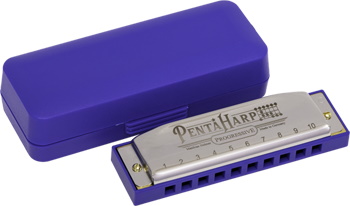 As Jason Ricci points out in his reviews however, the problem with new tunings is that as fast as you solve one set of problems, you create new ones. Consequently three user viewpoints have emerged. One camp is unequivocally pro the new tuning, one camp is evidently sceptical, and a third avoids offending the others by playing on the harp’s merits and concealing their own bias.
As Jason Ricci points out in his reviews however, the problem with new tunings is that as fast as you solve one set of problems, you create new ones. Consequently three user viewpoints have emerged. One camp is unequivocally pro the new tuning, one camp is evidently sceptical, and a third avoids offending the others by playing on the harp’s merits and concealing their own bias.
Put another way, firstly there are those who find the new tuning a welcome alternative to the challenges of the Richter tuned harmonica. Judging from YouTube, these largely (though not exclusively) appear to be guitarists and Hohner representatives. Then there are those who see it as an over-simplification of the tried and tested Richter layout. These generally (though not exclusively) appear to be seasoned harmonica players. Finally there are those who would probably prefer a Richter tuned harmonica, but are prepared to embrace the novelties of the PentaHarp.
If it was a bicycle, the PentaHarp would come with stabilisers pre-attached. Unless you go crazy, you won’t fall off. Alternatively, it’s like a harmonica ready meal. Lick your lips because you are in for a feast straight from the micro. The reality is that while you benefit from instant results, you miss out on learning to balance and the satisfaction of cooking to suit your own taste. Then again, monotony is the mother of improvisation. The full potential of the PentaHarp is possibly yet to be realised.
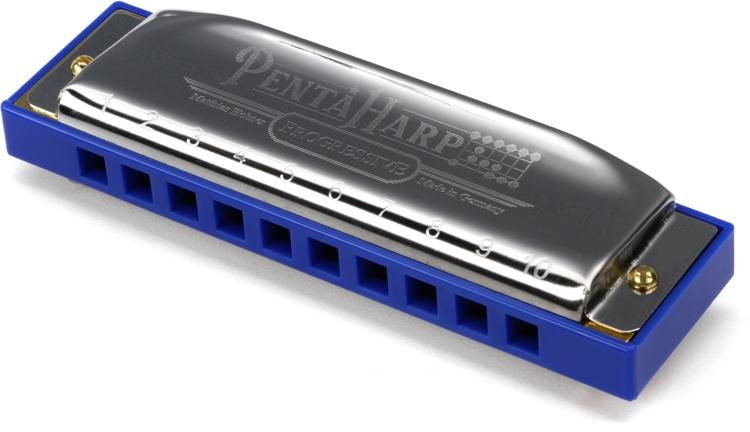 Minor Pentatonic and Blues scale explained
Minor Pentatonic and Blues scale explained
So why would a harmonica that plays the blues scale be branded PentaHarp? In short, because the minor pentatonic scale is the basis of the blues scale. Let’s work through the process. In theory a pentatonic scale is a sequence of any five notes that work well together melodically. At this level their selection is a matter of personal preference. However, centuries of musical development have served up two conventional systems: the major pentatonic scale and the minor pentatonic scale.
On the 10 hole Richter tuned harmonica in 1st position (which simply means we start and end our playing on a blow note in the key of the harmonica), the major pentatonic scale is readily located in 4B 4D 5B 6B 6D 7B. It’s the familiar major scale (do-re-mi-fa-sol-la-ti) with the fourth step (5D/fa) and seventh step (7D/ti) removed. Translated to 2nd position cross harp (which simply means we station our playing around a draw note five steps above the key of the harmonica; usually 2D), the major pentatonic is readily available as 2D 3D” 3D 4D 5B 6B. Being major, this system sounds jolly and upbeat. To western ears it also sounds distinctly exotic when compared to the major scale, but can be comfortably applied to country, Rock’n’Roll and Motown songs. Here’s Bobby McFerrin explaining its universal properties.
The minor pentatonic scale, in contrast, is sad and reflective. On a Richter tuned harp it can be readily located using cross as follows: 2D 3D’ 4B 4D 5D 6B. The start and end points are the same as the major pentatonic, but the pathways are different. While the switch from 3D” to 3D’ stands out as the main difference, the reversal of 5B to 5D is subtler, but incredibly important. When playing a major pentatonic number in 2nd position, inadvertently pulling 5D can be a pitfall for seasoned players used to the cross harp blues scale. Muscle memory overrides cognitive power and the result can be problematic. Put simply, in a live setting, drawing 5D over a major pentatonic melody really grinds the gears. Knowing how and when to select a pentatonic or blues scale is an important step in learning harmonica.
But what is the pentatonic scale’s practical use? The major pentatonic provides the underlying code for songs such as My Girl by The Temptations, Chuck E’s In Love by Rickie Lee Jones, or Hold Back The River by James Bay. It is a safe and reliable selection of tones with which to improvise over a stack of evergreens from Buddy Holly to Hank Williams. In a similar way, the minor pentatonic provides the underlying code for songs such as Summertime from Gershwin’s Porgy and Bess. The minor pentatonic offers up the same level of accessibility as the major pentatonic, but with one added twist. We eventually find ourselves connecting the central two tones in 4B and 4D by adding 4D’, whereupon we create a hexatonic (six note) system. This is the blues scale.
Solo tuning
 So how does all this apply to the PentaHarp? We’ve established that the PentaHarp derives its name from the minor pentatonic scale. Playing 1B 1D 2B 3B 3D 4B, or 4B 4D 5B 6B 6D 7B, or 7B 7D 8B 9B 9D 10B on a PentaHarp, we can map out the minor pentatonic scale very easily across three full octaves. In doing so, we pass over 2D, 5D and 8D, the notes that are pivotal to the blues scale. Adding these notes to the minor pentatonic scale is a convenient numeric solution to the instrument’s tonal layout. It also provides a splash of extra versatility and fun for harp players.
So how does all this apply to the PentaHarp? We’ve established that the PentaHarp derives its name from the minor pentatonic scale. Playing 1B 1D 2B 3B 3D 4B, or 4B 4D 5B 6B 6D 7B, or 7B 7D 8B 9B 9D 10B on a PentaHarp, we can map out the minor pentatonic scale very easily across three full octaves. In doing so, we pass over 2D, 5D and 8D, the notes that are pivotal to the blues scale. Adding these notes to the minor pentatonic scale is a convenient numeric solution to the instrument’s tonal layout. It also provides a splash of extra versatility and fun for harp players.
To the seasoned cross harp blues player, the outcome is akin to playing straight harp, or 1st position blues. It just demands time for habit breaking and mental readjustment. That being said, there is no bending to master, and the ‘pinch point’ between holes 6 and 7 on the ten hole Richter tuned harmonica is absent. Consequently we can flow the full length of the harmonica without changing a thing.
Any other business
Down to the nitty-gritty. The full PentaHarp layout for an A minor tuned instrument is show below. For those interested, it is possible to produce two semitone draw bends in holes 1, 3, 4, 6, 7, 9, and 10. Holes 2, 5 and 8 will produce a quarter-tone bend. It is also possible to overblow each of the blow reeds. With this information a seasoned player will no doubt identify some useful sequences using not only the natural notes, but also some bent position options.

The sound of innovation
Given a couple of hours of uninterrupted free time, a competent and curious harmonica player will not only adapt to the new tuning, but find themselves discovering some unique applications. Take this 12 bar uptown box blues pattern over a I, IV, V chord sequence as an example:
1B 1B 4B 4B 3D 3D 3B 3B / 1B 1B 4B 4B 3D 3D 3B 3B
1B 1B 4B 4B 3D 3D 3B 3B / 1B 1B 4B 4B 3D 3D 3B 3B
2B 2B 5B 5B 4D 4D 4B 4B / 2B 2B 5B 5B 4D 4D 4B 4B
1B 1B 4B 4B 3D 3D 3B 3B / 1B 1B 4B 4B 3D 3D 3B 3B
3B 3B 6B 6B 5B 5B 4D’ 4D’ / 2B 2B 5B 5B 4D 4D 4B 4B
1B 1B 4B 4B 3D 3D 3B 3B / 2B 2B 2D 3B…
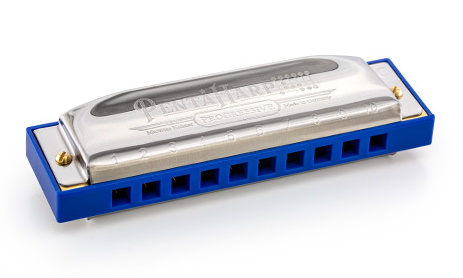 Also of interest, the major pentatonic scale is available in cross harp on the PentaHarp too. On an A PentaHarp, this gives us the C major pentatonic scale:
Also of interest, the major pentatonic scale is available in cross harp on the PentaHarp too. On an A PentaHarp, this gives us the C major pentatonic scale:
1D 2B 3B 3D 4B 4D / 4D 5B 6B 6D 7B 7D / 7D 8B 9B 9D 10B 10D
For a far eastern or folky effect, different intervals, octaves and a closing split chord are fun to explore:
1B=3B 1D=3D 2B=4B 1D=4D 2B=4B 1D=3D 1B=3B
3D=4D 4B=5B 3D=4D 3B=4B 1D=3D 1B-2B-3B-4B 1B-xx-3B-4B
Working from the perspective of relative major/minor chords, 10th position minor blues is also a real possibility (C minor on an A minor PentaHarp). If you play third position blues on a regular Richter tuned harp, the feel and layout her will feel quite familiar:
1D 2D 3D” 3D’ 3D 4D’ 4D / 4D 5D 6D” 6D’ 6D 7D’ 7D
Armed with this and a little practise, we can produce this kind of feel:
1D..2D..3D..4B ~4D ~4D / 5D..4D 3D’….3D” 2D 1D..4D
1D..2D..3D 4B ~4D..tr..5D / ~7D ~6D 6D”..5D..4D ~4D..tr..5D
Harp Surgery says
As with any major manufacturer’s latest model, a lot of excitement has been provided by the arrival of the Hohner PentaHarp. We would like to thank our friends at Hohner and Sutherland Trading for the opportunity to try one out first hand and share our findings. We’ve enjoyed exploring its 1st position minor pentatonic and blues layout, although we do miss the more expressive bent note combinations provided by a standard Richter tuning.
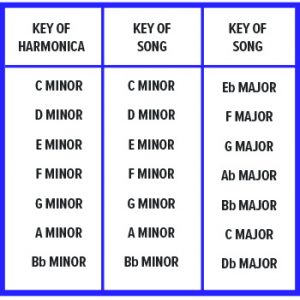
We have also enjoyed exploring the 10th position option, which has a great deal of mileage. Would we necessarily opt for this over 3rd position on a standard Richter tuned harmonica? Having spent so many years perfecting positional playing on a standard 10 hole, probably not, but it’s an option.
Do we see any value in the PentaHarp? Most certainly. Newcomers to the harmonica, guitarists and other musicians will find this an easy way to get started and add to their soundscape. Emulating the harmonica greats will prove difficult, but new applications are almost certainly waiting to be discovered. Educationally, many harp players are unfamiliar with the magic of pentatonic scales as opposed to blues scales. The PentaHarp may help to build more awareness of this important system. Here are some further observations:
PentaHarp – the pros
• Well built, airtight and responsive instrument
• Intuitive blow-draw solo tuning throughout holes 1 to 10
• Handy for guitarists using a rack and playing blues ‘in the box’
• Available in the seven most useful guitar keys
• 4 hole octave splits available (no need for awkward 5 hole octave splits)
• Useful educational tool for minor pentatonic and blues scales
• No longer tied to a folk tuning from the 1800’s
• 10th position blues available in skilled hands (eg Eb minor on C minor PentaHarp)
• Some draw bend and overblow embellishment notes available
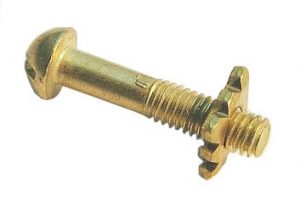
PentaHarp – the cons
• Ability to play single notes a pre-requisite
• Busking style and vamping not an option (eg Bob Dylan, Neil Young)
• Chords, double stops and intervals restricted (except for octaves)
• Trilling restricted
• Absence of the blues colour provided in Richter tuned bent notes
• Absence of convenient 2nd position blues options
• Conversion from PentaHarp to Richter a big challenge for newcomers
• A somewhat sterile experience compared to Richter tuning
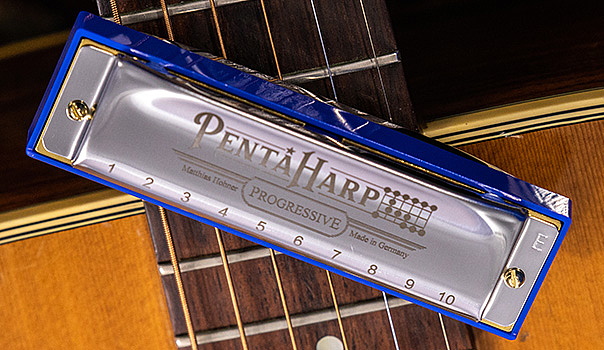 Tech spec and keys
Tech spec and keys
As with a Special 20, the PentaHarp reed plates are recessed for good air tightness. The cover plates are stainless steel, held on by old style slotted screws and Special 20 decorative nuts. The 0.9mm reed plates and reeds are made of brass. The PentaHarp is available in the minor keys of Low F, C, D, E, G, A, and Bb, with the root notes in 1B, 4B, 7B and 10B
Further information and resources
Hohner’s dedicated PentaHarp page – www.pentaharp.com
Hohner’s Top 10 Guitar Riffs for PentaHarp – PentaHarp Guitar Riffs
Hohner’s Harmonica Tab Generator – https://pentaharp.com/pentaharp-interactive/

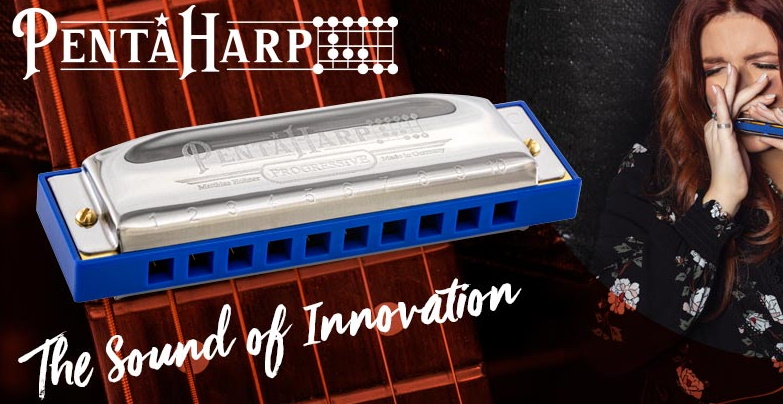
Where can I purchase one, and what is the price ? I’m not a very good player. Should I stick to the Marine Band ??
Hi Doug, thanks for your message. Buying one really depends on where you are based. Let me know and I can advise you further. In the UK you won’t get much change out of £50.00 GBP. Whether or not to buy one anyway? This will depend on your aims. I would say if you want to learn standard blues, folk or country tunes, then this may not be the harp for you. If you are a guitarist looking for a ‘failsafe’ way to accompany yourself using a rack mounted harmonica, and you have the budget, then go for it.
If I play a 12 bar blues in E on guitar, which Pentaharp should I be playing, ie, which key?
I want to start adding harmonica to my Dylan and Neil Young covers. From what I see, this may not be the best harmonica for those styles?
You’d need an E Pentaharp as the blues scale is arranged in a 1st position format.
Unless you’re playing a song based around the minor pentatonic/blues scale, then the Pentaharp wouldn’t really help you. To replicate the style of Dylan or Young, you’d need to use what they used in any case, which is a standard Richter tuned ten hole harmonica.
If my rock song is in the key of F# what key pentaharp should I play in? I don’t see an F# pentaharp.
Hi Rich – that’d be an F# Pentaharp, so you’re out of luck. They don’t come in that key. Options? Tune an F harp up or a G harp down. Or else buy a regular B diatonic and get cracking on your cross harp playing skills from 2 draw. apart from his, it serves you right for playing a song in F#!